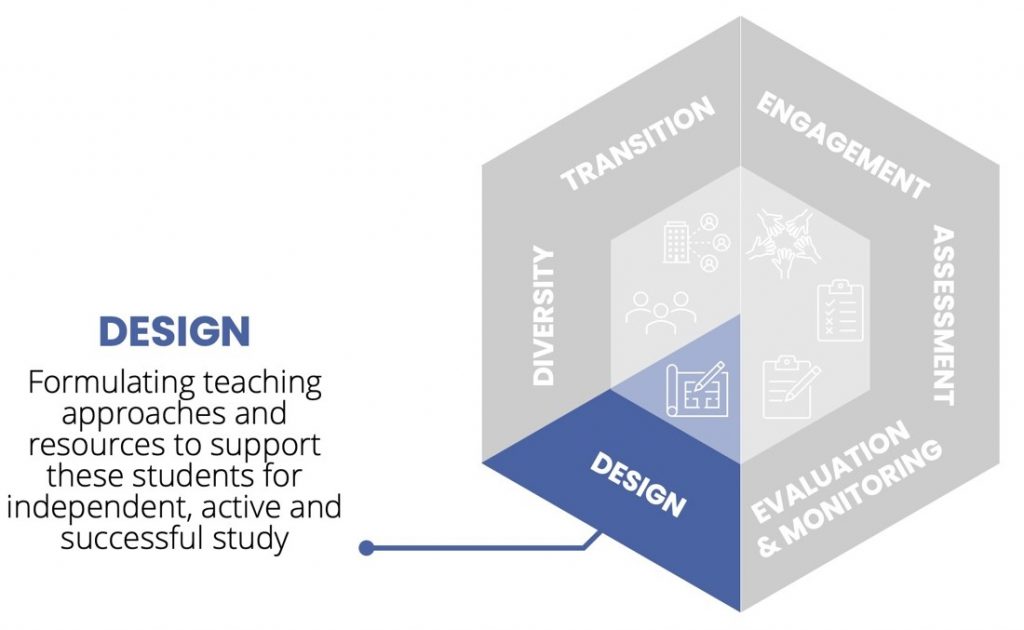- ffye
- First and Further Year Experience
- first-year curriculum principles
- transition
- transition pedagogies
This blog is part of a series co-authored by Kathy Egea and Jacqueline Melvold, and provides an overview of the principles of first-year curriculum. These are drawn from Transition Pedagogy (Kift 2009) and adapted for UTS purposes. Content is drawn from resources and practices through the First and Further Year Experience (FFYE) program, which has been using transition pedagogy since 2011. More depth can be found in the ‘FY Transition’ module developed by the co-authors, and is freely available on CAULLT’s Contemporary Approaches to University Teaching MOOC.
You can do so many things to ensure first-year students are set up for success – from ensuring students feel supported, to cultivating a sense of belonging, and finding effective ways to guide them into a fulfilling study experience. However, there is one principle that underpins all of the first-year curriculum principles, one that you’ll struggle to move forward without. That’s the principle of Design.
Principle #4: Design
Design underpins all of the first-year transition principles, allowing them to work together in an intentionally scaffolded way for students to be successful in their transition into their university studies. The benefits of good design are amplified when implemented at a degree level, and can support student engagement with learning environments through the purposeful integration and sequencing of knowledge, skills, and attitudes.

Design in practice
The following four concepts show the practical ways that the design principle can be used to develop supportive experiences for first-year and beyond.
1. Promote a climate of support and encouragement
- Humanising the learning environment (both online and face-to-face)
- Warm, wise tone and feedback
- University learning may be different to the student’s past experiences
- Remember that your task is to facilitate learning
- Be patient and flexible
- Facilitate and encourage contributions from all students in your class
2. Keep the focus on students: take an “active learning approach”
- Student-focused active learning, where students are encouraged to take responsibility for their own learning and engage in tasks – allow students time to grow
- Scaffold learning activities to develop student understanding of the content matter- such as peer discussion (pairs or groups), role playing, debating, assessing case studies or completing show written or mathematical exercises
- Design activities to include quieter students and second language students (e.g. think, pair, share approach)
- Help students to connect previous experiences with subject content
3. Provide effective scaffolding for classroom activities
- Be aware of the differing levels of preparedness and skills in your class – some students need more detailed explanations and structured tasks than others, while others may need more challenge
- Use peer learning for in-class tasks where possible
- Help students manage information overload throughout the semester by providing just in time support
- Begin where your students are at – start at the foundations and make no assumptions of student’s background knowledge
4. Design the right sequencing and activities
- Run timely, well-sequenced classes
- Focus student attention on key learning outcomes and how they map to the overall subject plan
- Have discussions about how concepts or issues being covered might differ from or be similar to what students have previously learnt
- Check in with your students learning at the beginning of class, and check out with what they have (and maybe haven’t) taken away from the class
From principle to practice
Below, we look at two case studies that support these concepts.
Case study: scaffolded reading practices in first-year Science
Dr Yvonne Davila and Neela Griffiths won a learning.futures award for their work in first-year design. They used an active and collaborative approach designed to develop student confidence (and capability) in reading and reviewing scientific literature. The practice of reading was developed as a three part model:
- Pre-class activities (interactive online module) in week 2.
- In class collaborative work (working with a journal article) week 2.
- Post class tasks (preparing an abstract) (formative assessment task).
You can download a copy of the case study for more information.
Case study: personalised learning studio-based projects
FEIT academic Gavin Paul has previously written about the design of the subject Introduction to Mechatronics Engineering, and it’s a great case study to show how effective design enhances the study experience for new students. In the video below (10:37), Gavin provides more information on how design was approached for this subject.
Download a transcript of the video here.
This personalised mechatronic project (‘Choose your own adventure’) is the final assessment in the first-year subject. Students are guided by a series of weekly activities to produce their personalised project, in which they:
- Submit ideation and learning contract with assessment rubric, with tutor feedback (same week)
- Submit finalised learning contract
- Undertake a quiz on progress
- Submit 1 minute trailer video of project (mostly completed)
- Showcase project in class, includes peer review and submission of design journal
The 6 principles
There are six First-year Curriculum Principles (FYCPs) linked to Transition Pedagogy. Click on the text to read our blog post about that particular principle.
